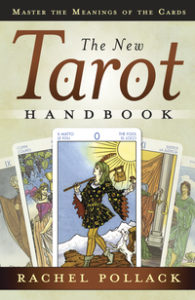Basking in the Light of the Star
Rachel Pollack’s New Tarot Handbook is a small book that packs a big punch. Each entry gives us traditional wisdom and unique insights. Pollack urges us to dive even deeper by creating a spread for each Major Arcana card.
We’ll let her guide us to the Star, shall we?
The Star
In the sequence of the Major Arcana, the most difficult section—the Fool’s Crisis, we might call it—begins with Death and reaches its culmination in the explosiveness of the Tower. The Star shows us that we have come through—we have cast off the Devil’s chains and found hope and openness. The Star resembles Temperance, the card between Death and the Devil, with some important differences. There we saw a powerful angel with divine symbols hidden in his robe. Here we see only a nude woman. There are five “naked” cards in the Rider Major Arcana (six, if you count the World), and all but the Lovers appear in the final group of seven cards. These cards take us beyond symbolic ideas to direct experience of powerful change.
Both Temperance and the Star show one foot on land and one in water—or on water in the Star’s case, for her foot does not seem to penetrate the ripples of the pond. What does this almost miraculous posture mean? If we see the water as the unconscious, the pool behind the High Priestess’s curtain, then we can stir it up and allow it to ripple but never truly penetrate it. In the next card, the Moon, we will see a creature half emerge from a similar pool.
Temperance pours water miraculously at an angle, careful not to spill a drop. The Star maiden pours water from two natural gourds, with nothing held back. This gesture links the card to Persephone, the Greek goddess of death and rebirth whose pomegranates we saw on the High Priestess’s curtain. At the end of Persephone’s Mysteries, a ritual held at the end of summer, the celebrants, led by the Hierophant, poured water from two vessels into cracks in the earth, calling out “Hye! Kye!” (“Rain! Conceive!”) to rejuvenate the ground after summer’s drought.
Persephone’s mother, Demeter, appears as the Empress, and the third triad runs Empress, Wheel of Fortune, Star. When both the Empress and the Star appear in a reading, they may symbolize a strong mother-daughter relationship.
Various people have suggested what actual star the card might indicate. (Remember, we have no record of what the deck’s original designers had in mind.) Some have said Polaris, the compass star that never deviates from its position over the North Pole, so that people can use it to navigate. And the eight- pointed Star resembles a compass, as does the eight-spoked Wheel of Fortune above it.
For myself, I see the Star as the planet Venus, called the Morning Star, the third brightest object in the sky after the sun and moon, and thus part of the natural progression of Starlight, Moonlight, and Sunlight. As the goddess of love, Venus is (like Demeter) the Empress, who bears Venus’s planetary symbol on her shield. But Venus is also the Devil, whom the Christians name Lucifer Morningstar. Venus disappears from the sky for part of the year, so maybe the Devil is love trapped in darkness, and the Star shows us Venus’s return, love reborn.
We can see a modern meaning in the very title of this card. Be a star. Shine. Don’t hide who you are, don’t let the Devil chain you with fears of people’s disapproval or scorn. Pour out your waters and discover your natural grace and beauty.
Divinatory meanings:
Hope, openness, calm, especially after a crisis or an explosion of some sort. Healing and regeneration. Be a star. Let others see the real you. Sensuality, physical confidence.
Reversed:
Doubt, pessimism, possibly a false hope. Shyness, sometimes a genuine need to hide something about yourself, at least in some particular situation.
A reading for The Star
Take out the Star card, look at it for a while, then set it on the table. Mix the rest of the deck and turn over one to three cards for each of the following themes:
- Hope
- Guidance
- Peace
- Healing










